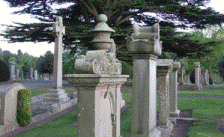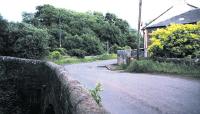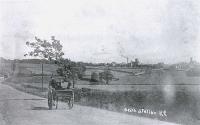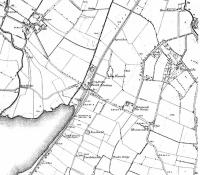- Birth*: John Conway was born on 28 February 1864 at Dundonald, Ayrshire, Scotland,
 .1
.1 - He was the son of Hugh Conway and Marion Ralstone.
- (Witness) Residence: John Conway lived at Glasgow & South Western Railway Station, Beith, Ayrshire, Scotland,
 ; The Glasgow and South Western Railway was a compactly arranged medium sized railway company which served the triangle forming the south-west of Scotland to Carlisle and Stranraer, with its headquarters at Glasgow. It became the third largest in Scotland and was formed by amalgamation of earlier railways in 1850, when the line from Glasgow to Carlisle was completed. The earliest constituent - although it was not formally taken over until 1899 - was the Duke of Portland’s privately financed Kilmarnock and Troon Railway of 1808-1812, built to carry coal from the Duke’s pits near Kilmarnock to Troon Harbour on the Ayrshire coast. This line had several ‘firsts’ for Scotland - the first railway viaduct (which still stands), first fare paying passengers, and first steam locomotive - although it was too heavy for the primitive tramroad track, otherwise horse operated.
; The Glasgow and South Western Railway was a compactly arranged medium sized railway company which served the triangle forming the south-west of Scotland to Carlisle and Stranraer, with its headquarters at Glasgow. It became the third largest in Scotland and was formed by amalgamation of earlier railways in 1850, when the line from Glasgow to Carlisle was completed. The earliest constituent - although it was not formally taken over until 1899 - was the Duke of Portland’s privately financed Kilmarnock and Troon Railway of 1808-1812, built to carry coal from the Duke’s pits near Kilmarnock to Troon Harbour on the Ayrshire coast. This line had several ‘firsts’ for Scotland - the first railway viaduct (which still stands), first fare paying passengers, and first steam locomotive - although it was too heavy for the primitive tramroad track, otherwise horse operated.
Coal was always an important part of the traffic owing to the many collieries in Ayrshire and associated ironworks, steelworks, brickworks and other industries. About 60% of the entire G&SWR wagon fleet were coal wagons, the company having a policy to strictly limit the numbers of private traders’ wagons authorised for use on its lines. In common with other railways the G&SWR carried a wide variety of general merchandise, and more specialised traffic like fish from the Ayrshire ports, boilers and machinery from works in Glasgow/Paisley/Renfrew area.
There was a consolidation of routes with various branches and inter-connecting lines being built up to 1906, two of the last being the coast line from Ayr to Girvan via Turnberry and Dumfries to Moniaive. In 1905 the Kilbirnie loop line was opened, which effectively doubled the capacity of routes from Paisley towards Ayr, as far as Dalry. Under the London, Midland and Scottish regime after 1923 in which the former Caledonian Railway was the dominant partner, the lines and stations saw little change until line closures began to be common after 1930.
Traffic on the Clyde Coast, serving numerous resorts amid outstanding scenery, was a very important aspect of the traffic, as well as minerals and the main line to London. The Glasgow and South Western developed its fleet of passenger steamers on the Firth of Clyde, which had a handsome livery of French grey hull with white topsides and paddle boxes, and deep red funnel with black top. These provided a service including the Isles of Arran, Bute and Cumbrae, and places on the mainland between Greenock and Stranraer, but were not permitted to carry passengers upriver from Greenock nor to sail to Campbeltown or Inveraray. Fast connecting trains serving Greenock Princes Pier, Ardrossan Winton Pier and Fairlie (near Largs) ran to and from Glasgow St Enoch in competition with the Caledonian Railway. However by 1908 this traffic was recognised as insufficient for the intense resources provided by the railway companies and pooling arrangements e.g. on the Ardrossan-Arran run were set up to share the use of steamers. Several steamers served in the First World War; ‘Mars’, ‘Neptune’ and ‘Minerva’ were casualties of this conflict, and never returned.
During the 1930s there was some small reduction in the network by closures of uneconomic routes, but more closures took place in the 1950s and others following the ‘Beeching Report’ or ‘Reshaping of British Railways’ of 1963. This also included a general reduction in goods facilities as more traffic turned to road competition. The last closure was as recently as 1983 being the Paisley Canal line and the remaining part of the Greenock branch, to Kilmacolm. However the tide was turning in favour of railways regarding local authority economic support. The Glasgow/Paisley to Ayr, Ardrossan and Largs lines were electrified by 1986 and part of the Paisley Canal line was re-opened in 1990, followed by re-opening of certain stations on other lines, particularly for commuters.4 - [S1] International Genealogical Index (IGI) (Salt Lake City, Utah, USA: International Genealogical Index), C115901.
- [S17] General Record Office for Scotland, online www.scotlandspeople.gov.uk, General Record Office for Scotland (Edinburgh, Scotland), Civil Parish of Beith; G&SW Railway Station, image held [Jun 2004].
- [S9] Website Ancestry.co.uk (www.ancestry.co.uk) Source Citation: Parish: Beith; ED: 3; Page: 8; Line: 7; Roll: cssct1881_180; Year: 1881. Source Information: Ancestry.com. 1881 Scotland Census [database on-line]. Provo, UT, USA: Ancestry.com Operations Inc, 2007. Original data: Scotland. 1881 Scotland Census. Reels 1-338. General Register Office for Scotland, Edinburgh, Scotland. [Aug 2011]
- [S49] Website Web Site online (www.) from A Short History of the Glasgow & South Western Railway (pub The Glasgow & South Western Railway Association) http://www.gswrr.co.uk/
John Conway
M, #540, b. 28 February 1864
Last Edited: 6 Aug 2011
Parents:
Relationship:
1st cousin 3 times removed of Patricia Catherine Adamson
 Genes on the Web
Genes on the Web



